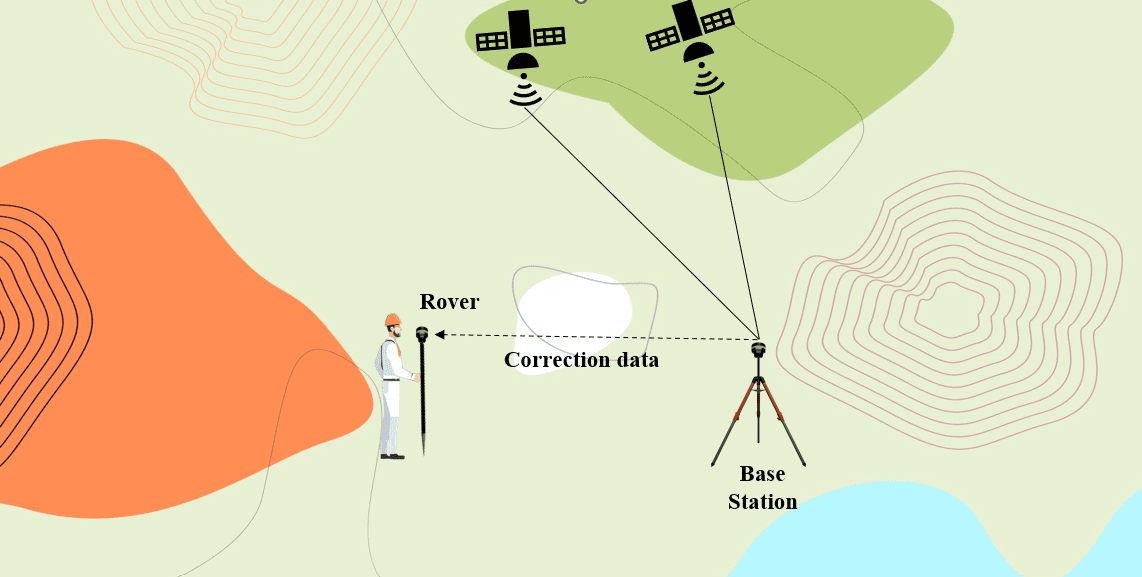Global Navigation Satellite System (GNSS) technology has transformed how we navigate and collect location-based data. Real-Time Kinematic (RTK) and Post-Processing Kinematic (PPK) are two cutting-edge methodologies that have greatly improved the accuracy and dependability of GNSS data. In this blog article, we’ll look at the concepts, uses, and benefits of RTK and PPK GNSS technology.
RTK and PPK are techniques used to enhance the accuracy of GNSS measurements:
Real Time Kinematics
This form of measurement occurs when we have a GNSS base that communicates directly with the GNSS rover and delivers corrections via radio transmission. In this approach, both the base and the rover get signals from the same satellites and through this direct radio link the corrections are transmitted in real time, achieving a high accuracy in the same field of data capture.

Pros of Real Time Kinematics
- Accuracy: RTK GNSS offers centimeter-level precision, making it ideal for applications requiring accurate location, such as surveying, construction, and agriculture.
- Real-Time Corrections: RTK applies corrections to the GNSS signal in real time, allowing users to acquire precise location data in a fraction of seconds. This capability is especially useful for applications requiring fast input or change, such as machine control in construction.
- Increased Efficiency: RTK technology allows for quicker data collecting and decision-making processes, which improves efficiency in a variety of applications. Surveyors, for example, may conduct fieldwork more rapidly with RTK, resulting in shorter project schedules.
- Versatility: RTK GNSS may be used in a wide range of settings and situations, from metropolitan regions with tall structures to broad open fields. Its adaptability makes it appropriate.
Cons of Real Time Kinematics
- Line-of-Sight Requirements: RTK GNSS requires a clear line of sight between the receiver and the satellites. Signal barriers, such as buildings, trees, or topography, might reduce performance and accuracy.
- Reliance on Base Station: RTK systems rely on a nearby base station to send correction data to the rover receiver. This reliance restricts the range of operation and may be impractical in distant or inaccessible places without a network of base stations.
- Vulnerability to Signal Interference: RTK GNSS signals are vulnerable to interference from sources such as electromagnetic interference (EMI), multipath reflections, and atmospheric conditions. Interference can impair signal reception and reduce accuracy, particularly in urban or industrial settings.
- Infrastructure costs: Setting up and maintaining RTK infrastructure, including base stations and communication networks, may be expensive, especially for large-scale projects or businesses with several locations. Furthermore, continuous subscription costs for correction services may increase the overall cost of RTK GNSS use.
Post Processing Kinematics
PPK is an alternative to RTK that applies positional corrections retrospectively. This means that in PPK mode, the GNSS rover and GNSS base station do not need to be connected when functioning. You simply need to record raw GNSS data (logs), which are subsequently processed to produce accurate positioning data that may be utilized for computations in postprocessing.
Post-Processing Kinematic (PPK) GNSS technology offers unique advantages.
PPK is an alternative to RTK that applies positional corrections retrospectively. This means that in PPK mode, the GNSS rover and GNSS base station do not need to be connected when functioning. You simply need to record raw GNSS data (logs), which are subsequently processed to produce accurate positioning data that may be utilized for computations in postprocessing.
Post-Processing Kinematic (PPK) GNSS technology offers unique advantages.

Pros of Post Processing Kinematics
- High Accuracy:Similar to RTK, PPK GNSS provides centimeter-level accuracy, ensuring precise positioning data for various applications such as surveying, mapping, and asset management.
- Flexibility in Data Collection:PPK technology allows users to collect GNSS data without the need for a real-time correction source or continuous communication with a base station. This flexibility is advantageous in remote or challenging environments where real-time corrections may not be available.
- Cost savings: With PPK GNSS, there are no continuing subscription fees or infrastructure expenditures connected with real-time correction services. This can result in cost savings over time, particularly for firms that do regular or large-scale GNSS surveys.
Cons of Post Processing Kinematics
- Delayed Results:Unlike RTK, which gives real-time positioning data, PPK GNSS requires gathered data to be post-processed in order to make corrections and obtain precise results. Depending on the processing procedure and software utilized, this could cause delays in receiving final positioning data.
- Post-processing Complexity: To use PPK GNSS, users must acquire raw GNSS data in the field and process it using specific software or algorithms. This procedure can be difficult and may necessitate training or experience to provide correct findings.
- Limited Real-Time Feedback:Without real-time corrections, users cannot discover and correct positional errors or anomalies during data gathering with PPK GNSS. Additional field checks or validation procedures may be required to verify data quality before results are finalized.
RTK and PPK GNSS technologies have transformed the landscape of precise positioning, enabling a wide range of industries to achieve unprecedented levels of accuracy in their location-based applications. As advancements in GNSS technology continue, the future holds even greater promise for enhanced accuracy and efficiency across diverse industries.
Thank you for reading.
About SurveyGyaan
SurveyGyaan is an educational initiative under the Surveyaan brand, which is a subsidiary of Nibrus Technologies Private Limited. Surveyaan specializes in drone manufacturing and the development of photogrammetry software.
Surveypod: www.surveypod.in (DGNSS Manufacturer Website)
Surveyaan: www.surveyaan.com (Drone Manufacturer Website)
Surveyaan Geoworkspace: app.surveyaan.com (Cloud Photogrammetry Software Website)

